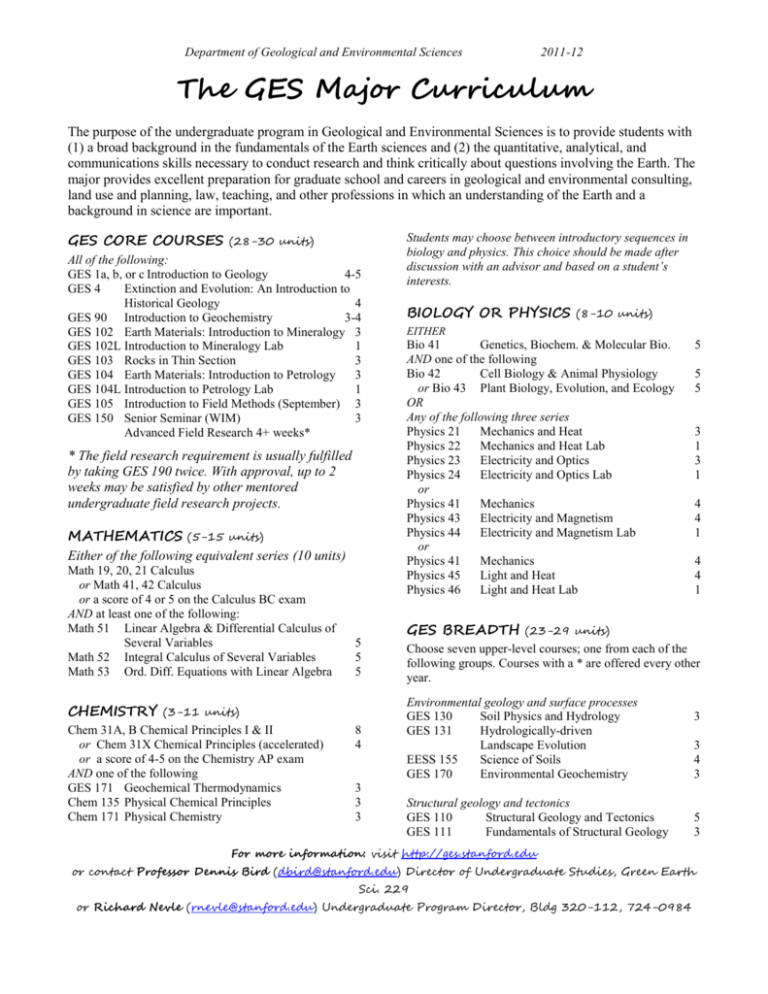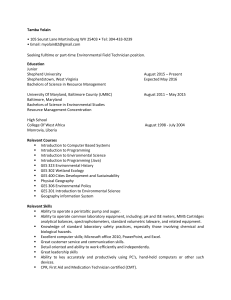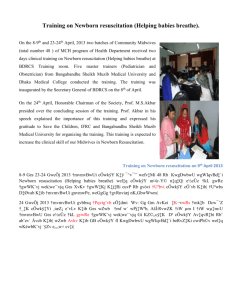The GES Major Curriculum - Stanford School of Earth, Energy
advertisement

Department of Geological and Environmental Sciences 2011-12 The GES Major Curriculum The purpose of the undergraduate program in Geological and Environmental Sciences is to provide students with (1) a broad background in the fundamentals of the Earth sciences and (2) the quantitative, analytical, and communications skills necessary to conduct research and think critically about questions involving the Earth. The major provides excellent preparation for graduate school and careers in geological and environmental consulting, land use and planning, law, teaching, and other professions in which an understanding of the Earth and a background in science are important. GES CORE COURSES (28-30 units) All of the following: GES 1a, b, or c Introduction to Geology 4-5 GES 4 Extinction and Evolution: An Introduction to Historical Geology 4 GES 90 Introduction to Geochemistry 3-4 GES 102 Earth Materials: Introduction to Mineralogy 3 GES 102L Introduction to Mineralogy Lab 1 GES 103 Rocks in Thin Section 3 GES 104 Earth Materials: Introduction to Petrology 3 GES 104L Introduction to Petrology Lab 1 GES 105 Introduction to Field Methods (September) 3 GES 150 Senior Seminar (WIM) 3 Advanced Field Research 4+ weeks* * The field research requirement is usually fulfilled by taking GES 190 twice. With approval, up to 2 weeks may be satisfied by other mentored undergraduate field research projects. MATHEMATICS (5-15 units) Either of the following equivalent series (10 units) Math 19, 20, 21 Calculus or Math 41, 42 Calculus or a score of 4 or 5 on the Calculus BC exam AND at least one of the following: Math 51 Linear Algebra & Differential Calculus of Several Variables Math 52 Integral Calculus of Several Variables Math 53 Ord. Diff. Equations with Linear Algebra BIOLOGY OR PHYSICS (8-10 units) EITHER Bio 41 Genetics, Biochem. & Molecular Bio. AND one of the following Bio 42 Cell Biology & Animal Physiology or Bio 43 Plant Biology, Evolution, and Ecology OR Any of the following three series Physics 21 Mechanics and Heat Physics 22 Mechanics and Heat Lab Physics 23 Electricity and Optics Physics 24 Electricity and Optics Lab or Physics 41 Mechanics Physics 43 Electricity and Magnetism Physics 44 Electricity and Magnetism Lab or Physics 41 Mechanics Physics 45 Light and Heat Physics 46 Light and Heat Lab 5 5 5 3 1 3 1 4 4 1 4 4 1 GES BREADTH (23-29 units) 5 5 5 Choose seven upper-level courses; one from each of the following groups. Courses with a * are offered every other year. 8 4 Environmental geology and surface processes GES 130 Soil Physics and Hydrology GES 131 Hydrologically-driven Landscape Evolution EESS 155 Science of Soils GES 170 Environmental Geochemistry CHEMISTRY (3-11 units) Chem 31A, B Chemical Principles I & II or Chem 31X Chemical Principles (accelerated) or a score of 4-5 on the Chemistry AP exam AND one of the following GES 171 Geochemical Thermodynamics Chem 135 Physical Chemical Principles Chem 171 Physical Chemistry Students may choose between introductory sequences in biology and physics. This choice should be made after discussion with an advisor and based on a student’s interests. 3 3 3 Structural geology and tectonics GES 110 Structural Geology and Tectonics GES 111 Fundamentals of Structural Geology 3 3 4 3 5 3 For more information: visit http://ges.stanford.edu or contact Professor Dennis Bird (dbird@stanford.edu) Director of Undergraduate Studies, Green Earth Sci. 229 or Richard Nevle (rnevle@stanford.edu) Undergraduate Program Director, Bldg 320-112, 724-0984 Department of Geological and Environmental Sciences GES 107 Earth materials and geochemistry GES 163 Introduction to Isotope Geochemistry *GES 180 Igneous Processes *GES 185 Volcanology 2011-12 Journey to the Center of the Earth 3 4 4 GES BREADTH IN THE MAJOR (continued) Geospatial statistics and computer science EarthSci 211 Computer Programming in C++ for Earth Scientists and Engineers Energy 125 Modeling and Simulation for Geoscientists and Engineers Energy 160 Modeling Uncertainty in the Earth Sciences EESS 161 Statistical Methods for Earth and Environmental Sciences: Geostatistics EESS 164 Fundamentals of Geographic Information Science (GIS) Geophys 112 Exploring Geosciences with MATLAB Geophys 140* Introduction to Remote Sensing 3 3 3 3-4 4 3 3 Sedimentary systems GES 151 Sedimentary Geology and Petrology (Win) 4 Biogeosciences *GES 123 Introduction to Paleobiology 4 Geophysics Geophys 110 3 Earth on the Edge: Introduction to Geophysics DEPTH IN THE MAJOR Students must take 10 units of electives primarily drawn from the list above and other upper-level courses in GES (including graduate-level courses). Additional courses in Geophysics, EESS, and ERE may be counted towards the elective units if they allow a student to pursue a topic in depth; these options should be discussed with an advisor. A maximum of 3 of the elective units may be fulfilled by GES 192, 197, 198, or advanced seminars. Honors research (GES 199) may fulfill up to 4 elective units. The GES Minor Curriculum The minor in Geological and Environmental Sciences is appropriate for students with a wide range of interests and backgrounds. To accommodate the variety of students who are interested, the minor program consists of a three-course core broadened by 12 units of electives. All students pursuing a minor in GES are encouraged (but not required) to participate in the Introduction to Field Methods (GES 105) which takes place in September, and the GES Senior Seminar (GES 150). CORE REQUIREMENTS (14-15 units) GES 1a, b, or c GES 4 GES 102 GES 104 An Introduction to Physical Geology Extinction and Evolution: An Introduction to Historical Geology) Earth Materials: Introduction to Mineralogy Earth Materials: Introduction to Petrology 4-5 4 3 3 For more information: visit http://ges.stanford.edu or contact Professor Dennis Bird (dbird@stanford.edu) Director of Undergraduate Studies, Green Earth Sci. 229 or Richard Nevle (rnevle@stanford.edu) Undergraduate Program Director, Bldg 320-112, 724-0984 3 Department of Geophysics 2011-2012 Expanding the discipline: Electives Students must take a minimum of 12 additional units drawn from the “Breadth in the Discipline” list in the GES major. Up to 3 units of Stanford Introductory Seminar courses in GES may be used to fulfill elective units for minors. A majority of units must be from classes within the GES department. For more information: visit http://geo.stanford.edu/GP or Professor Simon Klemperer (sklemp@stanford.edu) Director of Undergraduate Studies, Mitchell 353 or contact Richard Nevle (rnevle@stanford.edu) Undergraduate Program Coordinator, Bldg 320-112, 724-0984





